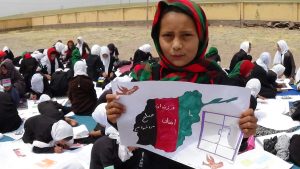Since 2001, the international community’s financial support has been the bedrock of progress in Afghanistan — delivering some of the fastest improvements in development outcomes in the world, with tangible impacts on the lives of millions. Today, as Afghanistan takes steps toward a peace agreement with the Taliban, it is apparent that continued support will be central to moving the development needle and ensuring peace in the years to come.
Against many key indicators, development outcomes in Afghanistan have shown some of the fastest progress in the world since 2001. The rate of access to electricity has increased from 8 percent to more than 30 percent; maternal mortality rates declined threefold between 2000 and 2015; and for every 1,000 births, 142 more children lived to the age of five in 2018 than they did in 2007. This progress can be attributed to development aid.
Furthermore, international support has helped us implement programs that increased access to education for women and reduced infant mortality rates. The fertility rate has declined from an average of 7.3 in 2002 to 4.6 children per woman. Over 8 million more Afghan children are in school, with the ratio of girls to boys enrolled in secondary school going up from 1:5 in 2003 to 1:2 in 2017. Reflecting expanded education and economic opportunities, a new generation of Afghan women are actively shaping Afghanistan’s future, playing key roles in government and the private sector. Today, while there is still some way to go, women represent a quarter of all civil servants and hold 16 percent of senior management roles.
Support provided through the multi-donor Afghanistan Reconstruction Trust Fund (ARTF) and the World Bank’s International Development Association (IDA) has been critical to achieving these numbers and success stories. Today, at this crossroads, it is vital that aid resources remain sufficient over the coming years to sustain these gains. World Bank analysis shows that with stable support over the medium-term, Afghanistan can accelerate growth, maintain development outcomes, and make real progress toward self-sufficiency.
But any precipitous reduction in grant support over the next few years will lead to major setbacks in public services, economic activity, and living standards. This is important not only for development, but also for peace. A political settlement with the Taliban is within reach. But it is difficult to see how peace can be effectively sustained amid deteriorating incomes, declining services, and increasing unemployment.
Afghanistan’s management of the crisis posed by COVID-19 has saved many lives and prevented a major economic setback from happening. Still, like in many other countries, our economy has been hit hard by the COVID-19 crisis. Lockdown measures to reduce the spread of disease have disrupted commerce; border closures have disrupted trade. Remittances from Afghans living abroad have declined as global economic conditions have worsened. With our economy expected to shrink by at least 5 percent this year, government finances are now under enormous pressure, and up to 6 million Afghans may have been driven into poverty.
Hence, our need is significant. With a new fiscal year on the horizon, we will need to make some difficult choices and tradeoffs to remedy shortfalls and demands from the COVID-19 recovery. We recently oversaw the development of a program-based national budget for the next fiscal year. The new national budget is transparent and accountable and cuts unnecessary expenditures with more appropriations for programs that have actual impact on the lives of Afghan people. At this point, any funding scale-backs could put this recovery in jeopardy and leave us in an even more precarious situation and impedes our progress toward meeting the Sustainable Development Goals.
As Afghans we are determined to become self-reliant. Among other measures, we are redoubling efforts to stamp out corruption through institutional and process reforms and establishment of a new overarching anti-corruption authority. Through long-term efforts to strengthen public finance systems, government revenues reached $2.7 billion in 2019 – about the average level for an economy of this size and shape. With increasing revenue and a growing economy, aid dependence has been declining over time. Grant flows have rapidly declined from around 100 percent of the economy in 2011 to around 43 percent today.
We would like to assure the international community of our intention to uphold this trajectory in our development progress. As our economy continues to grow and our revenues improve, we will be able to finance core services and infrastructure with much reduced external support. But self-reliance will take time. Grants continue to finance around 75 percent of total public spending and around half of budget spending, which is inflated by a large security sector dedicated to countering insurgency and threats of international terrorism. International aid pays for teachers’ salaries, road construction, the purchase of medicines, delivery of health services, and many other basic services.
We therefore appeal to the international community to protect the valuable investments and gains already made, notably by successfully completing the ongoing ARTF and supplemental IDA replenishment processes. Sustained investment will ensure that Afghanistan can continue its path out of fragility and prevent hard-won gains from being erased in the crucial years ahead.
Ashraf Ghani is the President of the Islamic Republic of Afghanistan.

































